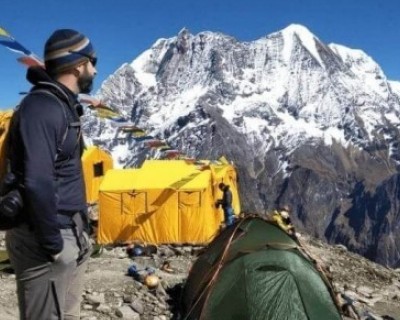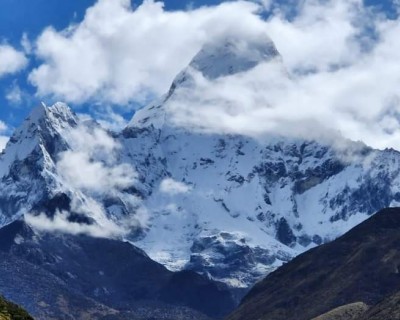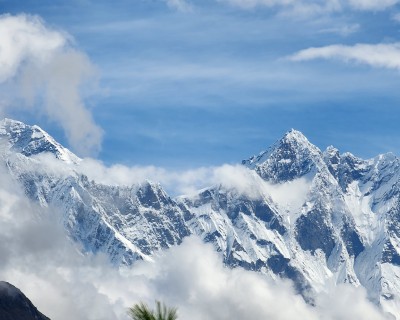Everest Base Camp trek detail before trekking (Complete guidelines for trekking to Everest Base Camp)
Seeing, the world's highest snow-capped peak Mt Everest with your own eyes is a lifetime experience. Exploring the jaw-dropping scenery and unique culture, walking through the challenging trekking routes around the Everest Region is amazing for one. But trekking here is not like having a cup of tea, you should be well prepared for the cost, itinerary, guides, porters, mountain sickness, goods packing, and many more.
Here is everything you need to know to have the best trekking experience in your lifetimes.
I came with the ultimate guide on how to Trek Everest Base Camp Trek successfully.
Everest Base Camp Trek overviews
The Everest Base Camp Trek takes you through the rough terrains and very steep climb, walking through the picturesque villages of the area makes your trips more interesting.
Taking the short adventure flight to Lukla which is around 35 minutes, your real adventure starts from here. Walking through the dense forest covered with bloomed rhododendrons, crossing the suspension bridges, enjoying the unique culture and tradition of the Sherpa people.
Following the route, you will encounter the glacier and many snow-capped mountains including Mt Everest, Nuptse, Lhotse, Ama Dablam, and many more.
Exploring Namche Bazaar's dense settlement of Sherpa people, and Tengboche monasteries the oldest and the highest altitude monasteries of the area.
Hiking Kalapatthar-the attractive vantage points of the trek that offer panoramic views of the surrounding snow-capped mountains including Mt Everest, Mt Lhotse, Nuptse, and many other surrounding peaks.
The Everest Base Camp Trek is very incredible!
Everest Base Camp Trek facts
- Destination: Everest Base Camp
- Trek difficulty: difficult
- Distance: 120 Km
- Trekking days: 12 days
- Total hiking/ascent: 6015 meters
- Total descent: 5821 meters
- Accommodation: Tea house/lodge
Major Attractions of Everest Base Camp Trek
Mt. Everest
.jpg)
Mt Everest is the highest and the most famous peak in the world. Walking to Everest, you will also see the world's fourth-highest peak Mt Lhotse, and also its neighboring peak Nuptse. The best place to view the stunning views of Mt Everest is from Kalapatthar. The summit views of Everest are blocked by Nuptse from the base camp until you reach Kalapatthar. Trekking to the Everest region you will also see the gorgeous fifth-highest peak, Makalu, and many more.
Kala Patthar
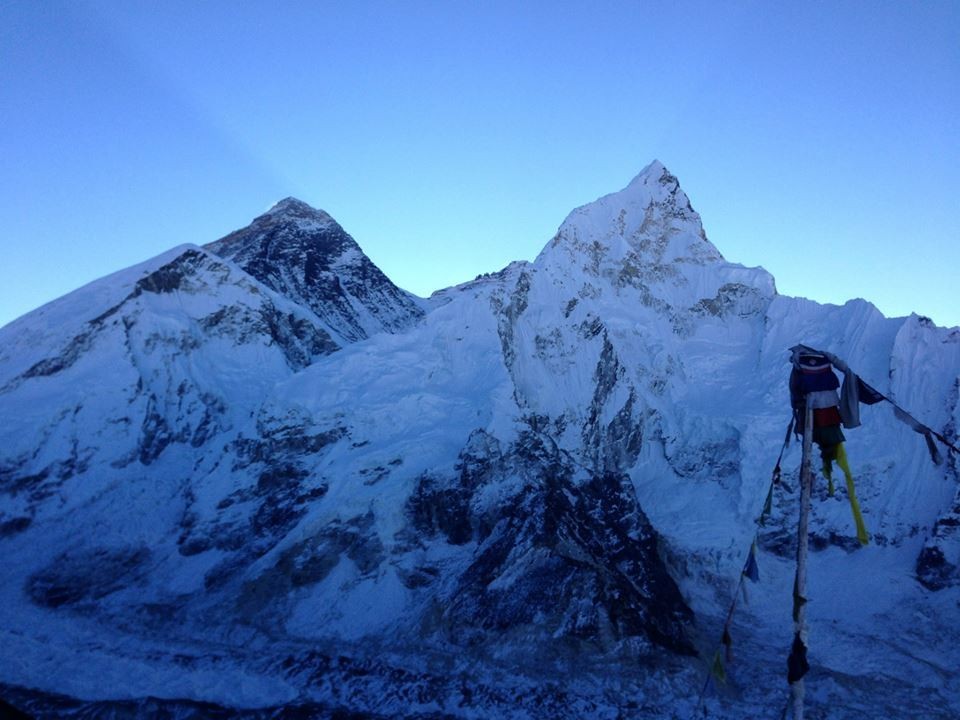
The attractive vantage point of the Everest Base Camp Trek offers you panoramic views of the surrounding snowy peaks which are usually blocked by the Nuptse from its base camp. A short hike to these rocky mountains will not disappoint you.
Kalapatthar offers you breathtaking views of Majestic Mt Everest, Mt Lhotse, Mt Nuptse, Mt Ama Dablam, and many more.
Everest Base Camp
.jpg)
Everest Base Camp is the base camp of the world's highest mountains and the dream destination of all the trekkers and adventure lovers but very few know that they cannot see the summit views of Mt Everest from its base camp. Trekking to Mt Everest is full of adventure and reaching its base camp is also a great achievement.
Trekking to the best camp on the giant peak is a really rewarding experience.
Tengboche monasteries
Tengboche Monasteries the oldest monasteries located in the Tengboche village in Khumjung, a monastery of the Sherpa community which is situated at an altitude of 3867 meters. This monastery is also the largest in the Khumbu region and offers panoramic views of the snow-capped peaks including Tawache, Thamserku, Mt Everest, Lhotse, and Nuptse.
Sagarmatha National park
Sagarmatha National Park is the country's first national park which was established in 1976 and is enlisted in the UNESCO World Heritage Sites. The park is located at the top of a hill in Namche Bazaar. The park protects the habitat of at least 118 species of birds, including Himalayan monal, blood pheasant, red and yellow billed cough, and many other rare birds. Sagarmatha National Park is also home to several rare mammal species including Musk deer, snow leopard, Himalayan Thar, Himalayan wolves, and many more are only found in this park.
Weather and temperature of Everest Base Camp Trek
As you know the weather at the high altitude cannot be simply predicted. The weather is unpredictable so you should be very careful if you are trekking in the Everest region during the off-season. Bad weather in the region increases the difficulty and challenges of trekking. But the weather starts quite stable while trekking in the peak season. But the temperature drops rapidly at night and can be reached below the freezing point so you should pack all the necessary layers and warm inner gear.
Trekking in the Everest region is prepared because even the start of the trek can be delayed because of the weather. The only means to reach the Everest region within a very short period is by taking a flight to Lukla. Due to bad weather, the early flights to Lukla often get canceled. The weather needs to be good to land safely in the Lukla airport. That is also the reason why Lukla is considered one of the most dangerous airports in the world. So while trekking in the Everest region you should have some extra days to cover your trek and make it smooth.
.png)
Everest region is the home to many small and the highest snow-capped mountains in the world ranging from 5500 meters to 8848 meters. Trekking here is easy and challenging at the same time depending upon the weather and temperature of the region. The route can be very challenging while climbing the passes in hot, rainy, or cold seasons. Avalanches and snow-falls can be the main reasons for death in winter.
Trekking in the Everest region is best in the spring and autumn seasons as the weather and temperature of that region remain stable and quite good at this time of the year.
Here we will discuss all four seasons in detail:
Spring season:
The Spring season is the peak season for trekking and climbing all kinds of peaks in Nepal. At this time of year, the weather is very stable, warm enough at the high altitude too, and offers clear views. The chance of a natural disaster, rain, or cloudy sky is less compared to other seasons. It is the peak season for climbing due to the very warm weather in high altitudes and not so much snow level in very high altitudes. The spring season lasts for three months from March to May. During this season, you can easily climb Kalapatthar and if you are planning to climb Mt Everest then this time will be very favorable. You can also easily trek Everest Three passes (Renjo la Pass, Cho La Pass, Kongma La Pass) without more difficulty compared to trekking in another season.
Due to the good weather, you can enjoy the clear views of the surroundings, the wind storms, and wind speed might be a problem for this season but taking into consideration these kinds of factors, trekking in the spring season is the best time to explore the Himalayan regions of Nepal with peaceful environment and clear views. You can also participate in the local festival at these times. The trek will be very experienced and memorable during this time of the year.
Monsoon Season:
Monsoon Season is considered as the off-season for trekking in the Everest region of Nepal. The months of June, July, and August fall in the monsoon season. At this time of the season, the air will be very clean and the surroundings will be greener. But the weather is not clear and the clouds might cause some difficulties to enjoy the views. Monsoon season offers clear and beautiful scenery as it usually rains during the night and continues for the next morning but in the morning the skies start to clear up, all the dust is washed away, and the clouds clear up and offer beautiful views of snow-capped mountains.
The monsoon season is also known as the rainy season. At this time of the year, the earth receives a large amount of rainwater. The merit point of this season is that the rain clears all the pollutants and dust off the trails, and offers clear crystal views of skies and snowy peaks. But the heavy rain can bring some insects like Leeches and bugs while walking through the forest. The route can be slippery and adventurous. If these things don't bother you then trekking Everest Base Camp in the monsoon season can be very beautiful. The route is less crowded so another advantage of trekking in this season is that you can get good accommodation and food facilities with a good discount. You don't need to worry about sharing your room with others. You can enjoy every walk of your journey with peace.
Autumn season:
The Autumn season is the best season for trekking and climbing in Nepal. The months of September, October, and November fall in these months. The weather is very pleasant and clear. Right after the end of the monsoon season, the autumn season starts beginning from mid-September and lasts till November.
The season offers clear visibility as you can enjoy the clear views of the snow-capped mountains as well as the surrounding nature. The weather during this time is very clear and fresh, neither too hot at low altitudes nor too freezing at high altitudes. The days are very warm and the nights are quite cool. But the sun makes the day very pleasant to walk. The average temperature is around 20°C during the day and falls to 5° Celsius at night at the high altitude. Although the night is pretty cool at the peak area, during the daytime it is very pleasant and warm.
Nature is still greenery, no disturbance of the weather and you can get clear views of the snowy peaks from a distance too.
Being the best time in the year to trek and explore, you will see many visitors on the route, it's pretty crowded and quite difficult to get a single room at a higher altitude so to avoid this problem, booking your room early is best.
Winter season:
The Winter season is the cold season of the year. The months of December, January, and February fall in the winter season. Every region of Nepal experiences a very cold climate. But if you are an adventure lover and want to trek in the month when the trail is quite peaceful and less crowded, then trekking in the winter season will be best. Being the less traveled trail during the winter season, you don't have to book your room in advance. You will also get a good discount on your accommodation and food.
The average temperature during the sunny day rises to 17° Celsius and at night the temperature drops below the freezing point. The temperature is very cold during the morning and night but during the sunny day, it is quite warm.
Trekking in the winter season is also very challenging as you will face a lot of challenges and difficulties. Heavy snowfalls and high levels of snow will disturb your walk. There are high chances of avalanches and other natural disasters too.
Due to the high snow-level pass, the high altitudes will remain closed. You will rarely see open teahouses in the altitudes as they all shift to low altitudes. Trekking in the cold climate in the high altitudes means you need to pack the right warm gear to be safe there. Besides, this season is good for those who want to enjoy a peaceful walk facing some difficulties and challenges with the mind-blowing snow-capped views.
Gear and equipment for Everest Base Camp Trekking
Trekking in the higher altitudes means you need to be well prepared for what to take and what not to. And during the trek, what to wear and what not to? You may have many questions crossing your mind. So here let's discuss the right gear to carry for your Everest Base Camp trek.
Trekking in different months means you need to carry different gear. For example, if you are planning to trek in the spring season you need to carry some warm gear as the winter has just faded, you also need to carry some lightweight dress for a day. If you are choosing to trek in monsoon season then you need to carry some waterproof gear. It means you need different gear in different seasons. So make sure to carry the right gear according to the weather.
Also remember, packing too much or too little can put you in many difficulties and also create many problems, so make sure to carry the right amount of gear. Carrying unnecessary things for the trek can make your walk at an altitude very difficult. You may not get the chance to enjoy your every walk and view the magnificent surroundings. So makes sure if you are trekking for the short day treks like Ghorepani Poon Hills and many others you just need to carry very little gear but if you are planning to spend more than a week in the high altitudes like Everest Base Camp, Everest base camp three passes, Annapurna Circuit, Annapurna Base camp then you need to carry more gears compared to short day trekking.
If you are still confused about packing your things, then here I have listed some important gear you should not miss:
Traveling bags:
- Day packs
- Duffer bags
- And Puck bags with waterproof covers
Head:
- Sunglasses
- Woolen hat
- Sun Hat
- Scarf
- Headlight
Upper body:
- Light T-shirt
- Waterproof jackets
- Thermal Vest
- Lightweight thermal tops
- Fleece Jackets
- Pullover
- Women's sports bra, synthetic
Lower body:
- Fleece pants
- Waterproof shell pants
- Lightweight walking pants
- Hiking short
- Undergarments
Handwear:
- Lightweight fleece gloves
- Heavyweight gloves
- Water and windproof gloves
Footwear:
- Hiking boots
- Camp sandals
- Pair of walking poles
- Thick warm wool hiking socks
- The inner socks
Other accessories:
- Sunscreen
- First Kids
- Sleeping bags
- Pillowcase and other night accessories
- Water purifiers
- Hand sanitizers
- Towel
- Wet wipes
- Toiletries
- Rain cover
- Sleeping bags
- Liner
- Earplugs
- Trekking poles
- Sunglasses
- Headlight
- Towel
- Lock
- Waterproof bags
- Camera
- Portable charger
- Books
- Cards
- Passport and money
Things to be careful during the Everest Base Camp Trek
Flight cancellation
One of the ways to enter the Everest region is by a direct flight to Lukla this flight offers gorgeous views of the mountains, unique flora and fauna, and many more but this flight highly depends upon the weather of the trekking day. Hence you need to have two or more than two average days which can cover your cancellation or lost day.
If you don't want to miss any day then there is also an alternative way to reach Lukla avoiding the flight, it means you can start or end your trek following the road head town of Jiri. It is the only road means and the trekking route before the airport at Lukla. But this also requires you a couple of days to reach the Everest region. Be patient and choose the route you want.
Altitude sickness
Altitude sickness is also known as mountain sickness and it is caused while hiking to higher altitudes, in other words it is simply referred to as the problem sticky in your body due to hiking quickly or hurriedly.
For the Everest Base Camp trek, remember that you will be walking to 5643 meters and at that altitude, there is very little oxygen than that in the sea level. If you do not adjust to it at such an altitude from the sea level, you may have trouble walking within a couple of hours.
You will discover several uncomfortable symptoms like headache, nausea, dizziness, and fatigue. Many other signs can also be seen. It is known as altitude sickness or Acute mountain sickness. Don't try to ignore these symptoms cause extreme altitude sickness can kill you too.
Here we have listed some signs and symptoms of altitude sickness with their preventative measures so if you discover any of this please share it with your friends or guide.
Sign/Symptoms
- Dizziness
- Fatigue
- Nausea
- Severe Headache
- Loss of appetite
- Difficult for breathing
- Problems in sleeping
Preventative measures:
- Drink at least 4-5 liters of water to keep your body hydrated.
- Avoid alcohol– it easily makes you dehydrated, stay far from tobacco, and don't intake medications like Sleeping pills while trekking at high altitudes.
- Avoid heavy exercise for 24 hours when the signs and symptoms of altitude sickness are first noticed.
- Follow the principle: climb high and sleep low. To stay far from altitude sickness, if you climb around 1000m per day then make sure to come down and rest at the lower altitude.
- Avoid meat and only consume the balanced diet food of local and traditional cuisine including Dal Bhat which is very rich in protein and increases your strength to walk in the altitude.
- Carry some chocolate bars to increase your strength and provide you with the extra energy to hike in the altitude.
- If you feel difficult, or uncomfortable, or identify any signs and symptoms of altitude sickness then immediately share with your friends or your professional guide and move to the lower altitude as fast as possible.
Everest cough
Everest/Khumbu cough is also a major aspect that you should be very careful about while trekking at Everest Base Camp. As you trek higher, you will get a cough that will be much more often. While coughing you will have severe pain. The best way to avoid the Khumbu cough is to use a mask. In this case, a handkerchief will just do fine. You can also use cough syrups or some candies to avoid coughing. So be very careful while trekking at a high altitude, always give priority to your body and health.
Insurance for Everest Base Camp trek
Trekking on the Everest Base Camp involves trekking to and from, hiking up and down as well as spending around one week or more than that in one of the most remote regions on the earth. As we said the trek is not dangerous but you can face many difficulties, challenges, and other various risks hence insurance is needed.
Insurance for trekkers is almost compulsory for any trekking because even a small injury during hiking such as a sprained ankle can create a nightmare and may prove to be quite costly.
Finding the correct insurance policy that covers all the loss of the events and environment associated with the Everest Base Camp trek is not an easy task so this article will help you by giving the detail of any insurance policy for the trek.
So your Everest Base Camp Trek insurance should include/cover your:
- Altitude sickness
- Accidents
- Baggage
- Illness
- Flight Cancellation
Guide and porter for Everest Base Camp Trek
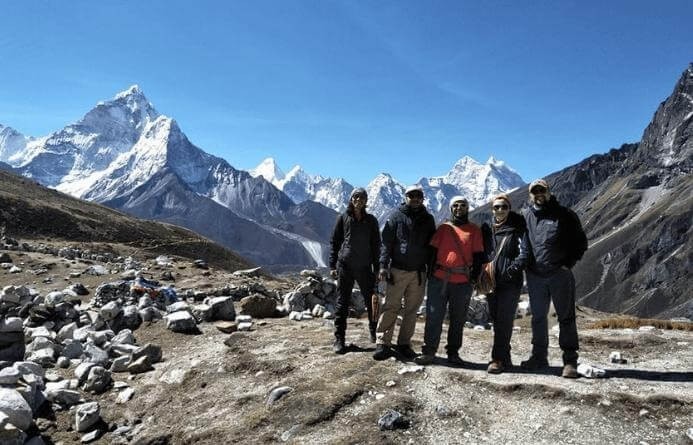
As we know Everest Base Camp Trek is very popular and offers stunning natural beauty, unique culture, and tradition, and the adventurous high altitude completes the region with beauty and challenges. But it is very difficult to do the solo trip to the Everest Base Camp.
Some treks like Annapurna Base Camp trek, Ghorepani, as well as Everest Base Camp are very well-managed with good facilities on the trek. and guide and porter is not compulsory for trekking on these routes but we highly recommend you hire a professional guide so that he can help you show the right direction and porter to carry your heavy luggage.
Trekking in the Everest Base Camp is both physically and mentally challenging so having an experienced guide will give you extra comfort, and make you feel free. Having a porter will lower the stress of carrying your heavy luggage. They will take good care of your safety and security and also will be the first responder during your emergency.
They help you to be familiar with the locals, tell you everything they know about the places, tell you details about the attractions of the trek, local cuisine, their culture, tradition, and many more things that you will be unable to collect and experience when you trek solo.
Taking a porter to carry your heavy luggage will help you to be stress-free during the walk and give you lots of spare time to enjoy the surrounding nature and view.
Here we have included the details and guidelines to make your Everest base camp trek very smooth, beautiful, and memorable. If you want to know more about the Everest Base Camp Trek Guide then please contact us: [email protected]. Have a great day!

.jpg)
